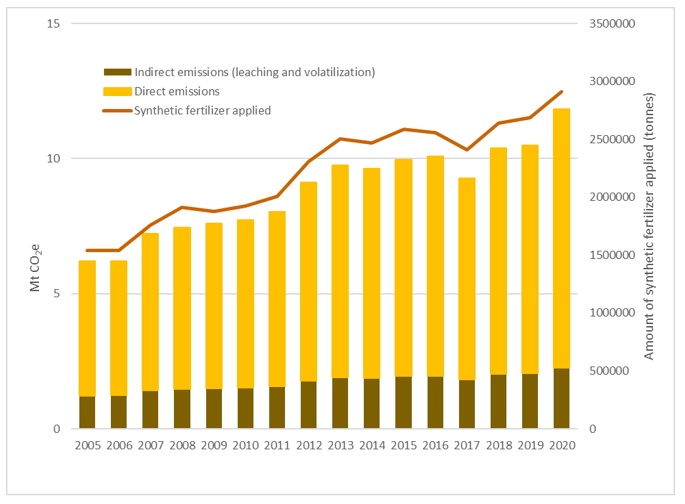Overview
Fertilizers are an essential input for Canada's agricultural crops. However, the application of nitrogen fertilizer results in a powerful greenhouse gas called nitrous oxide (N2O). This greenhouse gas contributes to climate change and is about 300 times stronger than carbon dioxide.
Agriculture and Agri-Food Canada (AAFC) is working in collaboration with the sector to reduce fertilizer emissions by 30% from 2020 levels by 2030. This target does not represent a mandatory reduction in fertilizer use. Instead, AAFC will support measures that producers can take voluntarily to reduce their emissions over the long term, without curtailing growth in crop yields. Taking action to adapt Canada's agriculture and food system to climate change will make important contributions towards improving food security.
A snapshot of current emissions
- Since 2005, nitrogen fertilizer use has increased by 93% and N2O emissions from nitrogen fertilizer use have increased by 94%. The intensity of emissions per hectare has slightly more than doubled since 1981. This is a result of increased fertilizer application rates coupled with only a minimal expansion of the total Canadian agricultural area.
- Emissions from fertilizer use are the only category of Canada's agricultural emissions projected to rise significantly through to 2030 under business-as-usual conditions.
Figure 1: Direct and indirect emissions from synthetic fertilizer application, 2005 to 2020 (NIR 2022)

Description of above image
| 2005 | 2006 | 2007 | 2008 | 2009 | 2010 | 2011 | 2012 | |
|---|---|---|---|---|---|---|---|---|
| Indirect emissions (leaching and volatization) (Mt CO2e) | 1.405451 | 1.40486 | 1.695978 | 1.695978 | 1.684187 | 1.706242 | 1.765864 | 2.003136 |
| Direct emissions (Mt CO2e) | 6.893705 | 6.873382 | 7.833271 | 8.182451 | 8.227483 | 8.3618 | 8.645521 | 9.765124 |
| Amount of synthetic fertilizer applied (tonnes) | 1539450 | 1539945 | 1756000 | 1913000 | 1878000 | 1924000 | 2009000 | 2311000 |
| 2013 | 2014 | 2015 | 2016 | 2017 | 2018 | 2019 | 2020 | |
|---|---|---|---|---|---|---|---|---|
| Indirect emissions (leaching and volatization) (Mt CO2e) | 2.154777 | 2.1114 | 2.186256 | 2.176803 | 2.027983 | 2.224113 | 2.194472 | 1.790625 |
| Direct emissions (Mt CO2e) | 10.43428 | 10.25529 | 10.56683 | 10.57919 | 9.747028 | 10.76751 | 10.5636 | 0.474449 |
| Amount of synthetic fertilizer applied (tonnes) | 2505000 | 2471000 | 2588000 | 2556000 | 2411000 | 2641000 | 2687000 | 2910000 |
Regional variations
Fertilizer emissions are not uniform across Canadian agricultural landscapes. Emissions are generated by the interaction between soil temperature, soil water and nitrate availability. Reducing emissions from fertilizer requires an approach that reflects regional considerations, such as the type of crop grown, the farm location, local weather, soil type, and other farm specific characteristics. To reduce emissions in a cost effective way, farmers will need to tailor their approach based on their local growing conditions.
Economic and environmental implications
Fertilizer plays a fundamental role for both individual farms and Canadian agriculture as a whole. Fertilizers have helped drive increases in Canadian crop yields over time, leading to increased grain sales and exports, record farm gate receipts, and prosperity for Canada's farm families.
Nitrogen produced by fertilizer can take different forms as it travels through the air, soil, and water, and the nitrogen that is not used by the growing crop can enter the broader environment with unintended consequences for water and biodiversity.
Given the essential role of nitrogen fertilizer in Canadian agriculture, actions to achieve emissions reductions will focus on improving nitrogen management and optimizing fertilizer use.
Financial supports available to agricultural sector
AAFC has a number of climate-smart financial support programs available to farmers to help reduce emissions from fertilizers and adopt beneficial management practices (BMPs):
- On-Farm Climate Action Fund
- Agricultural Climate Solutions - Living Labs Program
- Agricultural Clean Technology Program
Find out more about On-farm Climate Action Fund projects currently underway all across Canada.
Fertilizer Emissions Reduction Working Group
A Fertilizer Government-Industry Working Group was created through the Sustainable Agriculture Strategy Advisory Committee to facilitate ongoing dialogue with the sector as we work towards collaborative solutions to reducing greenhouse gas emissions from fertilizer application while maintaining yields.
Additional Information
- Discussion document: Reducing emissions arising from the application of fertilizer in Canada's agriculture sector - agriculture.canada.ca
- Document – Fertilizer Emission Reduction Consultation What we heard report
For information, contact us at aafc.fertilizer-engrais.aac@agr.gc.ca.